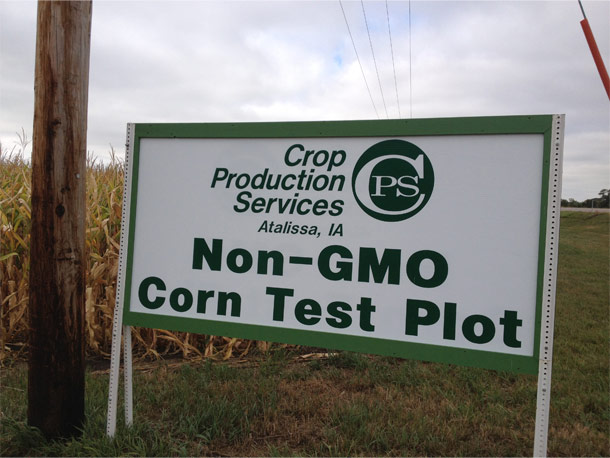More farmers may grow non-GMO and organic in 2015
By Ken Roseboro
Published: December 27, 2014
Category: Non-GMO Market News

To access all the articles in this month's issue of The Organic & Non-GMO Report, SUBSCRIBE NOW.
Low grain prices leading conventional farmers to consider more profitable alternatives
A growing number of farmers are considering planting non-GMO corn and soybeans as well as organic grains. A combination of factors including low prices for corn and soybeans, higher GMO seed costs, premium prices for non-GMO and organic grains, and failing GMO traits may push more farmers to go non-GMO or even organic.
Non-GMO sales higher this year
“Our non-GMO seed sales are significantly higher than last year,” says Gilbert Hostetler, president of Illinois-based Prairie Hybrids.
“We are seeing a lot of demand for conventional corn,” says Mac Ehrhardt, president of Minnesota-based Albert Lea Seed. “We took more orders for conventional corn seed by the end of last November than we did all last year.”
Ehrhardt distinguishes between conventional and non-GMO corn. While neither has GMO traits, Ehrhardt says farmers are planting conventional corn to cut costs, while farmers grow non-GMO to earn a premium price and must take extra steps to do so.
“There is a continued increased demand for non-GMO but most growth is in conventional seed,” Ehrhardt says.
Farmer interest in non-GMO soybean seeds is also strong, according to Wayne Hoener, vice president of sales for eMerge, an Iowa-based seed company.
Tim Daley, an agronomist at Stonebridge, Ltd., an Iowa-based buyer of non-GMO soybeans, also says seed companies report strong demand for non-GMO seed.
“Some companies have seen a 50 percent increase in sales of non GMO seed, and some have said they’ve sold more non-GMO seed this year than in the last five,” he says.
On the other hand, Morrie Bryant, senior marketing manager at Pioneer Hi-Bred, which sells non-GMO corn and soybean seeds but sells more GMO seeds, doesn’t see that strong of a demand for non-GMO seeds.
“On (non-GMO) corn, we’ve got a slight increase on sales over last year,” he says. “Non-GMO has emerged as the new niche. It’s about 4-5 percent of total corn production.”
Non-GMO more profitable, GMO traits failing
Farmers are looking at non-GMO production this year for several reasons, particularly economics. Grain prices are low with corn selling at about $4 per bushel and soybeans a little higher at $10. As a result, a premium paid for non-GMO corn and soybeans is more attractive to farmers.
“Non-GMO is more profitable,” Hostetler says.
“(Non-GMO) seed costs less, and there are premiums for non-GMO corn and soybeans in some areas,” Daley says.
“Some farmers don’t want to pay technology fees (for GMO seeds) and non-GMO gives them a marketing opportunity,” Bryant says.
Farmers can earn up to a $1.80 per bushel premium above commodity soybean prices for non-GMO soybeans grown for animal feed and $2.00 to $3.00 per bushel for soybeans grown for food use such as tofu. Premiums for non-GMO corn range from $.20 to $.40 per bushel.
Failing GMO traits are another reason why farmers are considering growing non-GMO.
“The insect and herbicide traits are losing effectiveness with increased resistant rootworm and weed species,” says a corn breeder who preferred to remain anonymous. “Growers are tired of paying for input costs that are reduced in efficacy and funding additional forms of crop protection.”
Iowa State University weed specialist Bob Hartzler agrees. “You have people questioning the value of the Roundup gene,” Hartzler told Iowa Farmer Today. “How many are doing it (making the switch) because of that concern, I don’t know.”
Non-GMO seeds are also producing competitive yields.
“The yield performance of non-GMO hybrids is similar to or greater than traited (GMO) hybrids,” says the corn breeder.
Hoener says companies producing non-GMO seed are developing varieties that yield as well as GMO varieties.
Farmers looking at organic
A recent article in the Des Moines Register newspaper said that low grain prices may lure farmers to go beyond non-GMO to organic production.
The organic food market continues to grow significantly, and sales are expected to increase 15 percent this year over last year’s $32 billion. In the past year, retail giants Wal-Mart and Target launched major initiatives to bring affordably priced organic food to more people. General Mills purchased organic food company Annie’s Homegrown for nearly $1 billion. Even fast food giant McDonald’s recently discussed plans to introduce organic products.
Organic growth is extending to the farm level, according to Lynn Clarkson, president of Clarkson Grain, an Illinois-based organic grain supplier.
“There is continual and accelerating growth in organic,” he says. “There has been more conversion to organic by farmers recently than I’ve ever seen.”
Ehrhardt also sees more farmers converting to organic production.
“A lot of acres that went out of organic production at the beginning of the recession are coming back and new acres also,” he says. “Farmers are looking for niche markets to make more money per acre.”
Prices for organic grains are about double those of conventional grains.
Beyond the economic gains, more organic agriculture benefits family farms and rural communities.
“Farmers can make a good living off a smaller number of acres, which keeps people on the farm and helps rural communities,” Ehrhardt says. “Organic is better for rural America.”
(Additional sources: Iowa Farmer Today, Des Moines Register)
© Copyright The Organic & Non-GMO Report, December-January 2015




